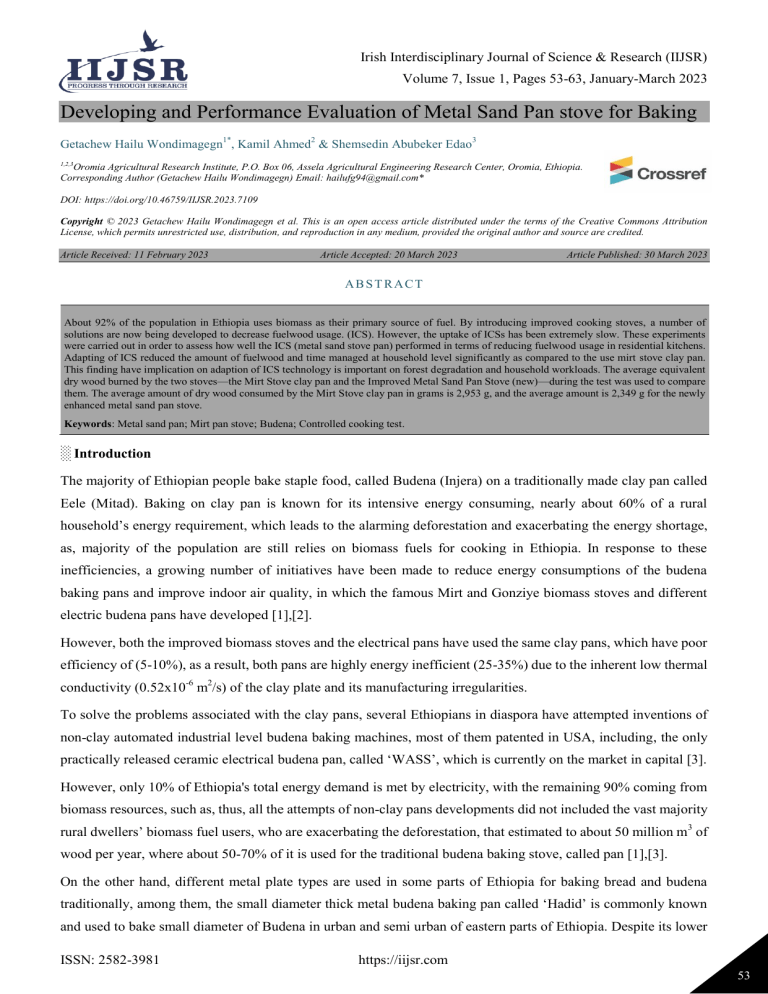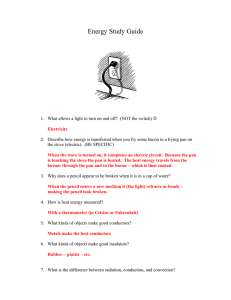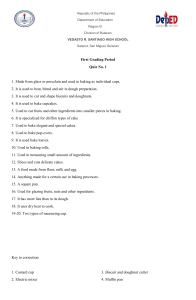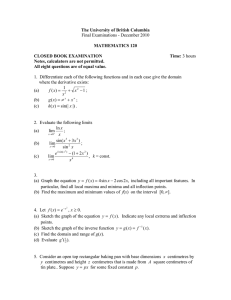Developing and Performance Evaluation of Metal Sand Pan stove for Baking
advertisement

Irish Interdisciplinary Journal of Science & Research (IIJSR) Volume 7, Issue 1, Pages 53-63, January-March 2023 Developing and Performance Evaluation of Metal Sand Pan stove for Baking Getachew Hailu Wondimagegn1*, Kamil Ahmed2 & Shemsedin Abubeker Edao3 1,2,3 Oromia Agricultural Research Institute, P.O. Box 06, Assela Agricultural Engineering Research Center, Oromia, Ethiopia. Corresponding Author (Getachew Hailu Wondimagegn) Email: hailufg94@gmail.com* DOI: https://doi.org/10.46759/IIJSR.2023.7109 Copyright © 2023 Getachew Hailu Wondimagegn et al. This is an open access article distributed under the terms of the Creative Commons Attribution License, which permits unrestricted use, distribution, and reproduction in any medium, provided the original author and source are credited. Article Received: 11 February 2023 Article Accepted: 20 March 2023 Article Published: 30 March 2023 ABSTRACT About 92% of the population in Ethiopia uses biomass as their primary source of fuel. By introducing improved cooking stoves, a number of solutions are now being developed to decrease fuelwood usage. (ICS). However, the uptake of ICSs has been extremely slow. These experiments were carried out in order to assess how well the ICS (metal sand stove pan) performed in terms of reducing fuelwood usage in residential kitchens. Adapting of ICS reduced the amount of fuelwood and time managed at household level significantly as compared to the use mirt stove clay pan. This finding have implication on adaption of ICS technology is important on forest degradation and household workloads. The average equivalent dry wood burned by the two stoves—the Mirt Stove clay pan and the Improved Metal Sand Pan Stove (new)—during the test was used to compare them. The average amount of dry wood consumed by the Mirt Stove clay pan in grams is 2,953 g, and the average amount is 2,349 g for the newly enhanced metal sand pan stove. Keywords: Metal sand pan; Mirt pan stove; Budena; Controlled cooking test. ░ Introduction The majority of Ethiopian people bake staple food, called Budena (Injera) on a traditionally made clay pan called Eele (Mitad). Baking on clay pan is known for its intensive energy consuming, nearly about 60% of a rural household’s energy requirement, which leads to the alarming deforestation and exacerbating the energy shortage, as, majority of the population are still relies on biomass fuels for cooking in Ethiopia. In response to these inefficiencies, a growing number of initiatives have been made to reduce energy consumptions of the budena baking pans and improve indoor air quality, in which the famous Mirt and Gonziye biomass stoves and different electric budena pans have developed [1],[2]. However, both the improved biomass stoves and the electrical pans have used the same clay pans, which have poor efficiency of (5-10%), as a result, both pans are highly energy inefficient (25-35%) due to the inherent low thermal conductivity (0.52x10-6 m2/s) of the clay plate and its manufacturing irregularities. To solve the problems associated with the clay pans, several Ethiopians in diaspora have attempted inventions of non-clay automated industrial level budena baking machines, most of them patented in USA, including, the only practically released ceramic electrical budena pan, called ‘WASS’, which is currently on the market in capital [3]. However, only 10% of Ethiopia's total energy demand is met by electricity, with the remaining 90% coming from biomass resources, such as, thus, all the attempts of non-clay pans developments did not included the vast majority rural dwellers’ biomass fuel users, who are exacerbating the deforestation, that estimated to about 50 million m3 of wood per year, where about 50-70% of it is used for the traditional budena baking stove, called pan [1],[3]. On the other hand, different metal plate types are used in some parts of Ethiopia for baking bread and budena traditionally, among them, the small diameter thick metal budena baking pan called ‘Hadid’ is commonly known and used to bake small diameter of Budena in urban and semi urban of eastern parts of Ethiopia. Despite its lower ISSN: 2582-3981 https://iijsr.com 53 Irish Interdisciplinary Journal of Science & Research (IIJSR) Volume 7, Issue 1, Pages 53-63, January-March 2023 diameter than the common clay pans, the ‘Hadid’ pans are commonly known for fuel saving as it is used non woody fluffy biomass fuels efficiently, in wood fuel constrained areas. Hadid, which is thicker metal (cast iron) has advantages of high thermal conductivity, 46.5 W/(m*K) as compared to < 1 W/(m*K) of clay. Recognizing the increased household spending on labor, time, or money as a result of physical decline and economic access to biomass resources and due to the country's rural areas' strong need for a fuel-saving budena baking device, it is crucial and opportune to maximize the use of the energy-efficient metal pan (Hadid), to substitute the inefficient clay pan and reduce the alarming deforestations caused by the budena baking. The purpose of this exercise is to create a budena baking pan made of Hadid (metal) that has a regularly used diameter (58–60 cm) and evaluate it for baking quality and biomass fuel efficiency. In addition, as the metals’ high thermal conductivity, is also associated with fast loss of heat and resulted in lower heat capacity, and some research findings attribute, to a somewhat unusual development of the eyes (holes) on its surface, while utilizing large diameter metal pan, as the cause of budena's peculiar appearance. which are blamed by some research results for influencing the distinctive appearance of budena, to a slightly different formation of the eyes (holes) on its surface, in using large diameter metal pan, which is not problem in the ‘Hadid’, therefore, modifications will be made by increasing the thickness of the metal/pan and including sand enclosing as heat storage to combine the advantages of both clay and metal characteristics for baking quality budena and saving biomass fuel efficiently. ░ Methods and Materials Materials The main raw materials would be 1.5- 2mm sheet metal thickness, different size sand and traditional clay pan used as need arise during in the process of experiments. Some of Equipment used for measurements and the experimental tests would be: spring balance, digital balance, thermometer, hygrometer, digital multi-meter, infrared thermometer, digital moisture meter, meter, caliper, lab sieves (different size sieves), stop watch, etc. Workshop machineries such as shearing, cutting, drilling, grinding, welding and etc, was used for construction (development) of prototypes. Prototypes preparation Raw materials used for construction of Sample pans were prepared as follows: The listed metals were purchased from market and used in the center’s metal work shop. Locally available and preferred sand was collected and sieved. For homogenous dispersion, the dry sand would be mixed thoroughly in various proportions by mass (based on the method of local potters). Accordingly, the sand would be then made to be enclosed in thickness of 26mm. Furthermore, two thicknesses of below and above the traditional pans thicknesses range, would be made in to 21.5mm sand-metal enclosing. Since, both metal and sand materials have the high thermal conductivity that has been blamed for causing little burn and low thermal capacity (storage) for slow burning of injera’s surface. ISSN: 2582-3981 https://iijsr.com 54 Irish Interdisciplinary Journal of Science & Research (IIJSR) Volume 7, Issue 1, Pages 53-63, January-March 2023 For this particular study project, sheet metal, sand, cement, and welding rod were the primary materials needed. The materials selected had been mainly based on local availability and cost-effectiveness. Two types of pans, having different thickness of metals and sand enclosing and without sand enclosing will be constructed. Construction of the pans prototypes was made in machine and metal workshops of Asella Agricultural Engineering Research Center. Prototypes that developed were tested in the center. After repeated testing of selecting better prototypes, further standard testing was done using control cook testing of pan. Both testing would be done in comparison with the traditional clay pan, to be purchased from local market randomly as a control for testing. In all testing sessions, the improved budena pan stove, called (Mirt) would be used by using the same type and mass of wood fuel. Mirt metal sand Pan stove Mirt Stove Clay Pan Figure 1. Mirt Stove Clay Pan and Mirt metal sand Pan stove ░ Performance Evaluation Version 2.0 of the Controlled Cooking Test (CCT) methods had been applied. The controlled cooking test (CCT) is designed to assess the performance of the improved stove relative to the common or traditional stoves that the improved model is meant to replace. Stoves are compared as they perform a standard cooking task that is closer to the actual cooking that local people do every day. However, the tests are designed in a way that minimizes the influence of other factors and allows for the test conditions to be reproduced. The main goals of this kind of test were to determine the time required to prepare a typical meal on a stove as well as the amount of fuel used, in units of mass or volume, to prepare a unit amount of food, in units of mass or volume once more. In order to determine whether there are any notable variations between the baseline and the new (hopefully improved) stove, these should be performed for both the baseline and the upgraded stoves. For each of ISSN: 2582-3981 https://iijsr.com 55 Irish Interdisciplinary Journal of Science & Research (IIJSR) Volume 7, Issue 1, Pages 53-63, January-March 2023 the stoves, at least three tests should typically be conducted, and for the results to be statistically significant, they must be consistent (i.e., repeatable). ░ Test Procedures and Equipment Used The teff dough used to make budena in our experiment was prepared well in advance and allowed to ferment for 4–5 days. The food preparation activity of interest is budena baking, and precise fuel consumption estimates in grams per kilogram as well as the amount of time it takes to prepare food in minutes were collected. As part of this very easy test, the budena components, fuel, and other test materials must be prepared. Additionally, the amount of fuel used before and after the test must be measured in order to calculate the net fuel usage. Both the fuel's moisture content and any leftover charcoal would need to be measured. Time measurements were also taken, as previously mentioned, and these were. Figure 2. Metal Sand Pan stove Testing When the wood fuel started to get burned, they were wiped off to pour the batter on the clay pan. Half minute after pouring the batter, the cover was closed and the budena was cooked for 3 minutes before taking it out from the baking pan. This procedure was repeated to bake 15–20 pieces of budena which is the usual amount baked per session for small number family a single household in Ethiopia. Before the test began, the batter bucket and the seified (plate used to extract and stack the injeras) were weighed. All stove holes were sealed when the test was ISSN: 2582-3981 https://iijsr.com 56 Irish Interdisciplinary Journal of Science & Research (IIJSR) Volume 7, Issue 1, Pages 53-63, January-March 2023 complete, and the stove was left to cool for a day. To determine the total amount of budenas generated and fuel consumed throughout the baking session, the ash from the ash container, the remaining unburned biomass, and the budenas produced and heaped up on the seified were all weighed. The following is a list of the measuring tools used: - A digital scale with a 5 kg weight range and a 100 g accuracy level to weigh the food and firewood. - a thermometer with a point thermocouple to measure the ambient temperature and a fuel moisture meter to ascertain the moisture content of the firewood - a stopwatch to keep track of the passing of time; - a measuring tape to gauge the size of the firewood utilized. ░ Determination of Pan Stove Performance Parameters Heating up Time Taken, Energy Consumption and Temperature of the Pans Thermal conductivity, heat capacity, and thermal diffusivity are the key determinants of a pan's energy consumption. The duration of the utensil's heating process is also influenced by the thermal conductivity and diffusivity. Here, the energy consumption of the pans was determined using the formulas below. Testing would be used to determine the pan's heating time and budena's baking temperature. The amount of time needed for the pans could vary depending on the type of stove and amount of wood energy used, thus, the same type and mass of wood would be used as fuel in the same stove (Mirt clay pan). The time taken to heat up the pan would be taken based on the judgments of experienced women as: Time of start (T0t) Time of heat up (T1) Additional Measurements: Average surface temperature of the baking pan before the start of baking. Total energy consumption of the pans with different thickness and diameter. Total time required to bake one and total budena per cycle (based on prepared volume of dough) were taken during the tests. Temperature distribution test on baking pan surface The surface temperature distribution of a baking pan utilizing an improved Injera stove was measured using an infrared thermometer. Six sites were used to measure the temperature distribution during the test to determine how the heat was distributed. However, because there is a substantial delay between measurements made close to the first point and the last points and just one thermometer is used to measure the temperature at each of the six places. Because of this, there could possibly be an unanticipated temperature differential. The amount of heat required for baking Equation provides the heat required to bring the cereal from room temperature to baking temperature(1-8); The heat loss during heating up Q1 M b Cb (Tb Ta ) ISSN: 2582-3981 (1) https://iijsr.com 57 Irish Interdisciplinary Journal of Science & Research (IIJSR) Volume 7, Issue 1, Pages 53-63, January-March 2023 Where:- Q1= heat needed, Mb= mass of budena, Tb= baking temperature and Ta= ambient temperature Heat loss through mpan during heating up for the pan is; Q2 M bCb (Tb Ta ) (2) QT Q1 Q2 (3) Where:- Q2 = heat needed, Mb= mass of budena, Tb= baking temperature and Ta= ambient temperature. Budena Baking per cycle T total (sec) = t heat up (sec) + n t baking (sec) + (n-1) (sec) t gap (sec) Where:- t heat up (4) – time taken during heat up, n– number of budena baked, t baking – time taken during one budena baking and t gap– time taken among two consecutive budena baking. The total energy intensity (Q) required per one cycle /or period/ was as follows: q total (J) = q heat up (J) + n q baking(J) + (n-1) q gap (J) (5) Where:- q heat up – energy consumption during heat up, q baking – time consumption during one budena baking, q gap– time consumption among two consecutive budena and n– number of budena baked Utilized Energy Intensity The heat applied to the budena is used to bring the batter's temperature up to the point at which water would boil. (in testing site). The useful energy (q useful) that was really required to bake one kilogram of budena can be stated as follows by taking into account the gross temperature rise of the product (sensible heat increase) and the latent heat of vaporization of evaporated moisture content: Quseful = mbatter cp (Tpt- Tb) +mw hvaporization (6) Where; mbatter – is an average mass of the batter, kg; Cp – average heat capacity, kJ/kg k, Tb – the teff fermented flour (or batter) temperature, 0C, Tpt – is the product surface temperature, 0C, mw– the moisture loss during baking, kg; and h vaporization − is the latent heat of water evaporation, kJ/kg. The total energy used for ‘n’ number of budena per cycle: qtotal= nq Efficiency of the pan Cooking energy efficiency is controlled by two parameters. Those are how heat is imparted to the food and how heat loss is controlled. The efficiency of pan for baking will be ηeele = q useful q input (7) Where, q input – total energy input to the pan and q Useful- useful energy which absorbed to the product. ISSN: 2582-3981 https://iijsr.com 58 Irish Interdisciplinary Journal of Science & Research (IIJSR) Volume 7, Issue 1, Pages 53-63, January-March 2023 ░ Result and Discussion Heat up temperature baking pan surface The temperature was measured at each point with infrared thermometer. Heating up surface temperature distribution of baking pan with metal sand pan budena stove. The temperature distribution across the surface of a metal sand-enclosing burner during baking with regard to time was measured. Each point's baking pan temperature was raised proportionately and in accordance with the application's requirements for budena baking. The biogas injera stove's baking process records a maximum temperature differential of 55 o C. The temperature was comparable between the standard type stove and the Mirt Injera stove's heat dispersion [8]. 300 TC Temperature in ℃ 250 TN 200 TS 150 TE TW 100 T NE 50 TNW 0 TSW 0 60 120 180 240 300 360 420 480 TSE Time in seconds Figure 3. Heating up temperature test on baking pan surface Equivalent Dry Wood Consumed The average equivalent dry wood burned by the two stoves—the Mirt Stove clay pan and the Improved Metal Sand Amount of wood consumed g/KG of food Pan Stove (new)—during the test was used to compare them. Mirt stove clay pan Metal sand pan stove 3500 3000 2500 2000 1500 1000 500 0 T1 T2 T3 Number of test Figure 4. Equivalent Dry Wood Consumed ISSN: 2582-3981 https://iijsr.com 59 Irish Interdisciplinary Journal of Science & Research (IIJSR) Volume 7, Issue 1, Pages 53-63, January-March 2023 The table below shows how the findings were presented. The average amount of dry wood consumed by a Mirt Stove clay pan is 2,953 g. and newly improved metal sand pan Stove is 2,349g on average. From this result the newly developed Improved Metal sand pan as a system saves 604 gram of equivalent dry wood when compared to previous developed Mirt budena baking stove. Specific Fuel Consumption A comparison of the two Stoves pan namely Mirt Stove clay pan (as control) and Improved mirt metal sand pan Stove (new) have been made with their respective Specific Fuel Consumption during the test. According to the findings depicted in the graph below, a metal sand pan stove uses 141 grams less specific fuel on average per kilogram of food cooked than a Mirt Stove, with a standard deviation divergence of 34. Therefore, the difference between Mirt stove (as control) and improved metal sand pan Stove is has decreased on average by 141 g/kg of Specific fuel consumption. Developing a multi-fuel injera mitad applicable in combination with existing energy saving and relatively cleaner stoves. The proven high demand for a fuel saving injera baking appliance in Ethiopia Specific fuel consumtion g/kg justifies the further optimization of the multi fuel injera mitad [7],[8]. Mirt stove clay pan Metal sand pan stove 500 400 300 200 100 0 T1 T2 T3 Number of test Figure 5. Specific Fuel Consumption Cooking time(min) The Baking Time 88 86 84 82 80 78 76 74 72 70 68 T1 T2 T3 Number of Test Figure 6. Baking time stove pans The stove used as control Mirt stove clay pan takes long time 85 min in average to bake 15-20 of budena. Whereas mirt metal sand pan stove took about 77 min. The baking of budena took place with same quantity of dough of ISSN: 2582-3981 https://iijsr.com 60 Irish Interdisciplinary Journal of Science & Research (IIJSR) Volume 7, Issue 1, Pages 53-63, January-March 2023 under the same conditions. The mirt metal sand pan stove baking time with a remarkable 9% difference from the Mirt stove clay pan Thermal Efficiency The thermal efficiency of budena baking biomass mirt metal sand pan stove was 17.5% while the efficiency of the mirt stove clay pan for budena baking was 16.5%. Because the mitad requires greater temperatures (180–220°C) than boiling water does, the heating phase of the budena baking process takes up 35% of the overall baking time. A lighter mitad pan the efficiency of Mirt stove clay pan ranges between 19 to 21% while With a heavier mitad, the efficiency was dropped to a range of 16- 17%[6]. the greater utilization of the heat The initial prototype was made of metal. Injera has a unique appearance due to the lower heat capacity of metal than clay [1] Table 1. Mirt Metal sand pan stove with Mirt clay stove performance result Type of budena baking Stove Description Mirt Stove Mirt metal sand pan stove clay pan Test 1 Test 2 Test 3 Average Time store heat(min) 23 25 24 24 21 mbudena(kg) 8.5 7.8 9.1 8.5 8.6 Number of budena baked (pcs) 20 18 19 19 18 Baking time (min) 80 75 76 77 85 Cp,budena,(kJ/kg.K) 3.4 3.4 3.4 3 3.4 Tboil (℃) 92 92 92 92 92 Tbatter (℃) 22 21 23 22 21 mevp(kg) 6.2 5.1 4.7 5.4 5.3 hfg (kJ/kg) 2260 2260 2260 2260 2260 mfuel(kg) 5.5 4.6 5 5.1 7.17 Hvchar(kJ/kg) 18640 18640 18640 18640 18640 Qinjera (MJ) 19 19.6 19.4 18.7 20 Qfuel (MJ) 146 153 139 146 184 Qchar (MJ) 29 44 33 35.3 23 Qnet input (MJ) 117 109 106 110.7 121 Thermal Eff.(%) 15.4 16.8 16.6 17.5 16.5 ISSN: 2582-3981 https://iijsr.com 61 Irish Interdisciplinary Journal of Science & Research (IIJSR) Volume 7, Issue 1, Pages 53-63, January-March 2023 ░ Conclusion and Recommendation The majority of people who live in underdeveloped nations utilize biomass for cooking and baking, and budena baking is one of the most popular forms of cooking in Ethiopia and other countries in eastern Africa. These findings indicated that there is opportunity for development by further lowering the heat losses from the stove, increasing the number of budenas baked per session, and reducing the heat up time between successive baked budenas. For the purpose of baking budena, the temperature of the baking pan's surface increased and varied throughout time. The findings showed that by baking more budenas per session and decreasing the heat losses from the stove pan, heat up time between consecutive baked injeras, and other factors. Additionally, the unit cycle time reduction (to bake a single budena) and the quantity of budenas to be baked determine the overall time reduction, which becomes more significant as the quantity of budenas to be baked increases. Heat storing time of the metal sand baking pan which was 24 min and mirt stove clay pan was 21 min. In the years to come, budena will remain Ethiopians' main source of nutrition. Research and development for budena baking is essential in order to bake budena effectively utilizing a variety of stoves. Electricity and biomass are currently the two main energy sources utilized to bake injera. The thermal conductivity of the baking pan can also be improved through research without sacrificing the quality of the budena. A metal sand baking pan, or budena, is another topic that needs more research, particularly in terms of heat efficiency, material properties, and budena quality. Additionally, little emphasis was paid to lowering carbon emissions or reducing indoor air pollutants like CO and PM, with the majority of studies on budena baking stoves concentrating on reducing particular fuel usage. Declarations Source of Funding This research did not receive any grant from funding agencies in the public, commercial, or not-for-profit sectors. Competing Interests Statement The authors declare no competing financial, professional, or personal interests. Consent for publication The authors declare that they consented to the publication of this research work. References [1] Adem KD, Ambie DA. (2017). A review of injera baking technologies in Ethiopia: Challenges and gaps. Energy Sustainable Dev., 41: 69–80. [2] Alula Gebresas, Asmamaw T., Hadush B., Abdelkadir K. (2013). Improving energy consumption and durability of the clay bakeware (mitad). International Journal of Software & Hardware Research in Engineering, 11(3). [3] Awash Tekle (2011). Experimental investigation on performance characteristics and efficiency of electric injera baking pans (“mitad”). MSc thesis, AA University. ISSN: 2582-3981 https://iijsr.com 62 Irish Interdisciplinary Journal of Science & Research (IIJSR) Volume 7, Issue 1, Pages 53-63, January-March 2023 [4] Danas Electrical Engineering - Energy Efficiency Standards and Labeling. Project document on Electric Injera Mitad, May 2015. [5] Kamil D.A., Demiss A.A., Maria P.A., Ulrik B. He., Jesper A. and Tobias P.T. (2019). First injera baking biomass gasifier stove to reduce indoor air pollution, and fuel use. AIMS Energy, 7(2): 227–245. doi: 10.3934/ energy.2019.2.227. [6] Mesele H.H., Mulu B.K., Asfaw Ha. T., and Oumer I.D. (2017). Energy consumption performance analysis of electrical mitad at Mekelle city. Momona Ethiopian Journal of Science (MEJS), 9(1): 43–65. [7] Putz, K. and J. Muller (2011). Development of a Multi Fuel Mitad as Stove Extension for Injera Baking in Ethiopia, in Development on the margin. [8] Derese, Buzayehu Mulugeta, and Shewangzaw W. Demissi (2021). Improved biogas ‘Injera’ bakery stove design, assemble and its baking pan floor temperature distribution test. ISSN: 2582-3981 https://iijsr.com 63




